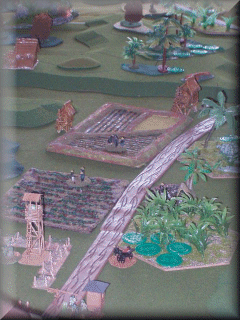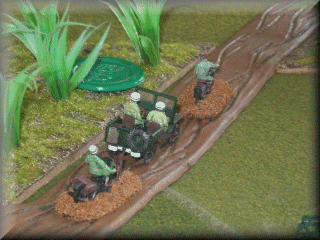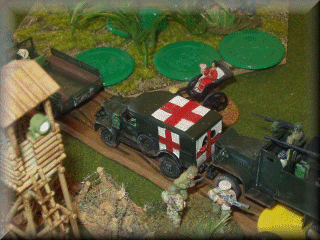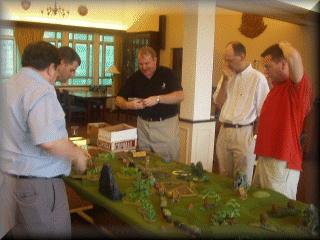Lt.
Col. Chasse shuffled the papers on his desk and tried to make sense of them:
operational orders; intelligence reports; eyewitness accounts; all full of
information, full of detail but Chasse knew that they would only go part of
the way to telling him what happened that day.
It didn’t really matter.
Hanoi
wouldn’t be interested in his report.
Three good young officers killed would be just another personnel
problem for them, just another reason to push
Paris
for more, just another reason to hurry another intake of cadets out of St.
Cyr and Da Lat and into the cauldron of
Indochina
. But Chasse had liked all three
of them, he owed it to them to tell their stories ~ they deserved it and it
might be useful for those coming after them.
Chasse
thought back to his first letter to Bonenfant
nonchalantly describing the situation in the sector.
He had been impressed with Bonenfant’s workmanlike reply.
Clearly although Bonenfant was new to the Delta he knew his stuff.
Of course in this infernal county these orders were probably in Viet
Minh hands before they were in Chasse’s hands, but Chasse couldn’t help
thinking that even the Viets would have been impressed.
Chasse
turned to the bloodstained operational orders
taken off the dead enemy company commander.
Chasse recognized that he was up against a professional here, a Viet Minh
commander who had spent considerable time in the training schools of
Southern China
and even more time at the front. Yes
Bonenfant and Je were well matched. Chasse
smiled when he saw that even the Viet Minh had problems with their logistics
~ and as in any army the biggest problem was usually the quartermasters who
believed that stores were called “stores” because if they were meant to
be issued they would be called “issues.”
 Of
course orders do not survive contact with the enemy.
That is where the eyewitness accounts came in.
They told of the happy atmosphere at Ben Mi that morning.
The convoy had already made it more than half way unmolested.
When they had stopped to deliver mail and supplies to the fortified
“Point Kilometre” Base at PK 37,
Captain
Ky
commanding the Vietnamese National Army garrison had made Bonenfant welcome
in his mess and introduced him to Lt Chane, Chasse’s own artillery
commander who would accompany him back to Bac To.
Perhaps they were too happy, too relaxed.
For, after Chane joking about requisitioning a civilian saloon car in
the convoy as his personal transport, they decided to share Bonenfant’s
command jeep. Chasse’s eyes
arched skyward in exasperation at this point: experienced officers putting
Of
course orders do not survive contact with the enemy.
That is where the eyewitness accounts came in.
They told of the happy atmosphere at Ben Mi that morning.
The convoy had already made it more than half way unmolested.
When they had stopped to deliver mail and supplies to the fortified
“Point Kilometre” Base at PK 37,
Captain
Ky
commanding the Vietnamese National Army garrison had made Bonenfant welcome
in his mess and introduced him to Lt Chane, Chasse’s own artillery
commander who would accompany him back to Bac To.
Perhaps they were too happy, too relaxed.
For, after Chane joking about requisitioning a civilian saloon car in
the convoy as his personal transport, they decided to share Bonenfant’s
command jeep. Chasse’s eyes
arched skyward in exasperation at this point: experienced officers putting
“all
their eggs in one basket” ~ when would we ever learn that the Viets would
not forgive any elementary mistakes like this?
Je’s
plan was simple and robust as suited his troops.
His veteran company and the heavy weapons would take out the convoy
whilst the larger green company would conduct a text book attack on the
fortified PK. Machine guns and
mortars would put down fire from across the road whilst the infantry would
attack at right angles to the base of fire.
The assault on the post was to be led by treachery!
That was the Viet Minh way of doing things.
As
the convoy left the PK “all hell broke loose,”
The convoy itself was stopped at the front by a roadblock but the
initial salvo of bazooka and recoilless rifle rounds left the stalled
vehicles relatively unscathed. Further
back however Bonenfant’s command jeep came under sustained sniper, mortar
and HMG fire. Bonenfant and
Chane scrambled into the paddy next to the road.
It wasn’t clear from the reports whether they were untouched, or
wounded, or already dead at this point, but they, and their orderlies and
radio men, were to undergo constant enemy fire for the next hour.
To all intents and purposes the convoy was now leaderless.
Inside
the PK a “Trinh Sat” reconnaissance squad posing as villagers had used
satchel charges to attack the command bunker, which housed
Captain
Ky
and the post’s HMG. Although
not destroyed outright the banker was suppressed and, like the convoy, the
Pk should have been leaderless, but a young man, so boring and abstemious
that they called him “the Bishop” as a pun on his Vietnamese name: Giam,
the lieutenant in charge of the second platoon of the PK’s garrison showed
that whether on the Communist side or the Nationalist side there was no
discount on Vietnamese bravery that day.
Chasse
had to admit that the Viet Minh assault on the PK was well coordinated.
The bunker was suppressed by the “Trinh Sat” attack and, although
Giam’s men in the barracks gave covering fire they too were hard pressed
by the Viet Minh heavy weapons bearing upon them from the village across the
road. Then, under cover of
smoke, the Viet Minh assaulted the bunker, urged forward by their political
officer comrade Trang. From the
accounts he read Chasse could not help respecting, even admiring, Trang.
As the novice Viet Minh because stuck on the wire surrounding the
bunker Trang steadied them, disentangled them, and led them through the
cleared lanes. Then, as
belatedly French artillery started to fall in support of the bunker, Trang
led the assault and seized the heart of the fortified post ~ it seemed that
the Viet Minh would sweep all before them.
 Meanwhile
the battle for the convoy twisted and turned.
At the head of the convoy the “Route Controller” Military Police
had come across the roadblock and, although surviving the initial barrage of
machine gun and bazooka fire, had de-bussed into the jungle.
Chasse shrugged. The
jungle belonged to the Viet Minh and only traffic cops like “le flics”
would have ignored that ~ they were quickly dispatched by a Viet Minh
section waiting in ambush.
Meanwhile
the battle for the convoy twisted and turned.
At the head of the convoy the “Route Controller” Military Police
had come across the roadblock and, although surviving the initial barrage of
machine gun and bazooka fire, had de-bussed into the jungle.
Chasse shrugged. The
jungle belonged to the Viet Minh and only traffic cops like “le flics”
would have ignored that ~ they were quickly dispatched by a Viet Minh
section waiting in ambush.
After
their first volley the Viet Minh heavy weapons found their range.
The M8 Greyhound armoured car was suppressed and under cover of this
fire a Viet Minh platoon surged forward, assaulting and destroying the M8.
They then worked their way up the convoy but miscalculated.
The White scout car which should have fallen easily to them contained
a French reconnaissance squad and a short, sharp skirmish left many Viet
Minh dead at the roadside.
 At
the tail end of the convoy, stuck in the crossfire between the village and
the PK, chaos reigned. The
escort platoon of French regulars debussed from their Dodge, scampered into
the ditch leading back to the PK … and stayed there for the rest of the
action. Veterans all, they had
got to that status by not risking their necks for anyone ~ and were not
about to change now. But at the
very rear of the convoy came an armoured “gun truck” armed with a 40 mm
Bofors and a .50 cal HMG. After
overcoming some minutes of stunned inertia, the gun-truck finally opened up
with its devastating firepower to give both the rear of the convoy and the
PK the relief they needed.
At
the tail end of the convoy, stuck in the crossfire between the village and
the PK, chaos reigned. The
escort platoon of French regulars debussed from their Dodge, scampered into
the ditch leading back to the PK … and stayed there for the rest of the
action. Veterans all, they had
got to that status by not risking their necks for anyone ~ and were not
about to change now. But at the
very rear of the convoy came an armoured “gun truck” armed with a 40 mm
Bofors and a .50 cal HMG. After
overcoming some minutes of stunned inertia, the gun-truck finally opened up
with its devastating firepower to give both the rear of the convoy and the
PK the relief they needed.
Inside
the PK, with the fire from the village reduced,
Siam
was able to move one of his squads into the mess hut.
This gave his platoon mutually supporting fires across the PK and
when Comrade Trang tried to move his men across this beaten ground even the
smoke of his mortars could not protect him from the crossfire.
Chasse marvelled as he read the witness reports of Trang trying time,
and time again, to rally his stunned troops for one final assault.
Despite all his exhortations he was never able to get more than one
squad to its feet and finally, in exasperation led only them into the
attack. The Nationalist
Vietnamese in the barracks held their ground, the Viet Minh were cut down,
but they found a posthumous hero in Trang.
Chasse shuddered: with men like Trang leading them the Viet Minh
would raise the stakes of this war to a point where even
France
would fold. It might take time,
and thousands of French and Vietnamese lives, for
Hanoi
and
Paris
to realize that, but the truth was plain for Chasse to see.
 Beyond
the PK Je had set about using his heavy weapons and last functioning platoon
to destroy the military part of the convoy.
A Vietnamese Nationalist patrol had taken one of his squads by
surprise but had been destroyed when it pushed its luck and assaulted Je’s
headquarters. The lesson should
have been clear but perhaps even a wily old fox like Je had been carried
away by the excitement. Instead
of withdrawing with his task more than half complete he redeployed to take
on the PK, only to find himself ravaged by the fire of its defenders and the
“gun truck.”
Beyond
the PK Je had set about using his heavy weapons and last functioning platoon
to destroy the military part of the convoy.
A Vietnamese Nationalist patrol had taken one of his squads by
surprise but had been destroyed when it pushed its luck and assaulted Je’s
headquarters. The lesson should
have been clear but perhaps even a wily old fox like Je had been carried
away by the excitement. Instead
of withdrawing with his task more than half complete he redeployed to take
on the PK, only to find himself ravaged by the fire of its defenders and the
“gun truck.”
French
firepower was bound to prevail in the end, but with Bonenfant and Chane
incapacitated, it had taken a long time to bring the artillery, air and
ground resources that should have given the French an overwhelming
superiority to bear. Without a
forward controller the batteries at Bac To had deviated over the target
area, admittedly doing damage because the Viet Minh were so thick on the
ground, but rarely doing damage where it counted.
The French total superiority in the air had counted for little.
There was a “big push” on that day and all the B26s were diverted
to missions well away from lowly PK 37.
A Criquet observation plane had improved the artillery fire for about
half an hour but even it had left before the only Bearcat sortie of the day
arrived. Without good direction
the Bearcat loosed its ordinance on some peasants in the paddy fields.
Finally
however the armoured reaction platoon from Bac To broke through to the
convoy. The tanks, gun carriages
and half tracks quickly manoeuvred against the Viet Minh rear.
Je, realizing that the tide had turned, made off to fight again, but
Bu Ngyet, the commander of the second company seemed to seek death as he led
his headquarters against the French tanks ~ to an inevitable end.
As
the “Bisons” broke through to the PK the recriminations started
immediately. The dazed French
and Nationalist survivors had no doubt that they had almost been brought
down by treachery. Their
response was swift and brutal, and, as later, more reasoned intelligence
analysis was to show, totally misdirected against innocent villagers.
Chasse
sifted through the motorpool’s report of vehicles destroyed, burned out
and, even worse, looted of their heavy weapons, radios and first aid kits.
The Viets had made a good haul. The
command jeep was a complete write off. Probably
just as well thought Chasse ~ with two convoy commanders bleeding to death
in the same jeep within a fortnight he would have been hard put to find
another comfortable passenger for it in future.
Chasse
finished his report.
Hanoi
would read it as almost a victory. Two
Viet Minh companies had been destroyed for half a convoy and a Vietnamese
National platoon. Good for
Hanoi
thought Chasse. He still had
more paperwork to do. He looked
in the files for the addresses of Bonenfant’s, Chane’s
and Ky’s next of kin. The hard
writing of the day was yet to begin.
The
Game
The
game was played at the October 2003 meeting.
Tim Goodchild visiting from
Singapore
via
Dien Bien Phu
was the eponymous “Bonenfant.” Ken
Chan was “Chane” and James Bishop was “Ky” and “Giam” ~ or
Bishop in Vietnamese. On the
side of the masses Jeff Herbert was company commander “Je”, Neil Burnett
was company commander “Bu Ngyet”, and the political commissar Comrade
Trang was played by a 20 mm high lump of lead whose determination and
courage, (if not his dice rolling,) won the heart of all present that day.
 Both
Tim and Jeff put a lot of effort into their pre-game orders which was an
obvious indication that “the suspension of disbelief,” so important to a
good game, was well underway. The
game was played using “Crossfire” rules with my
Indochina
amendments and the “moving clock.” Tim
had never used these rules before but he was soon up to speed.
Both
Tim and Jeff put a lot of effort into their pre-game orders which was an
obvious indication that “the suspension of disbelief,” so important to a
good game, was well underway. The
game was played using “Crossfire” rules with my
Indochina
amendments and the “moving clock.” Tim
had never used these rules before but he was soon up to speed.
By
way of treachery, or “preparing the battlefield” as the Viet Minh prefer
to call it, Jeff was given full access to the French order of march and Neil
had a “Trinh Sat” squad inside the post posing as peasants to make a
satchel charge attack. Although
the village head, (who, in his defence, had seen his predecessor murdered,)
had assured the French that the village was secure, the Viet Minh were
allowed to deploy throughout it.
Jeff’s
plan was very workmanlike and well suited to the capability of his troops.
Really he intended to fight two separate battles:
His own veteran company, supported by most of the heavy weapons would
take out the convoy; whilst Neil’s larger but less well trained company
would conduct a classic attack against the post, using heavy weapons in the
village as a base of fire whilst the infantry assault moved in at right
angles to it.
The
Trinh Sat squad had a choice of three targets: the command bunker, the
mortar pit or the barracks where Giam’s platoon was sleeping.
The former was the most important, but the best protected.
What
Jeff didn’t appreciate was the length of the convoy.
We had played a similar convoy ambush game before with him as the
French but in the year or so since then I had been happily building more and
more vehicles. Thus the convoy
was much larger than Jeff expected so, although his chosen ambush point was
halfway down the table, the rearguard had not yet left the village when the
Viet Minh struck. As a result
the rear of the convoy tended to work in concert with the post defenders and
this went a long way to finally defeating Neil’s assault.
Jeff now assures me that I have “enough” vehicles, but, being a
lifelong wargamer, I have no idea what that word means!
Neither
Tim nor Ken were able to come up with a convincing reason as to why they
chose to both travel in the same vehicle.
It cost them clearly as the Viet Minh mortars, snipers and machine
guns first pinned, then suppressed, then killed them over the next hour.
The air and artillery amendments worked well.
Without a forward observer the potentially devastating French
artillery was delayed and inaccurate; and Ken had an uncanny knack of
throwing for B26 bombers to arrive when I don’t have one.
(In the car on the way home Ken was seriously considering building
one for the next game. If he
does I shall have to make him Viet Minh!)
When French air support eventually arrived they misacquired their
target and bombed some poor peasants instead.
The
game played out as described by Chasse above.
It was fast and furious although, in circumstances like this, time
seemed to pass slowly ~ i.e. we had lots of initiatives but the French could
not get the dice scores necessary for the “moving clock” to advance.
If there were three critical decisions in the game they were:
-
James’
splitting Giam’s platoon, a risky move it itself, but when he
accomplished it his squads were able to give each other supporting fire
and the Viet Minh were unable to use smoke or covering fire to
neutralize the whole platoon.
-
Jeff,
having demolished the front of the convoy, redeploying to help the
assault on the post and exposing himself to the fire of the rear of the
convoy and the post. This
was a calculated risk that didn’t come off.
One
of the most interesting bits of the game came after it ended when the French
players were asked to identify who had betrayed them.
Although there had been several clues throughout the game the French
players, nice chaps and gentleman all, acted on their instincts and chose
civilians that they didn’t like the look of and were in the wrong place at
the wrong time … innocent civilians as it turned out.
I hadn’t intended this as any kind of morality test but it was an
interesting insight ~ someone, I suppose, has to be to blame.